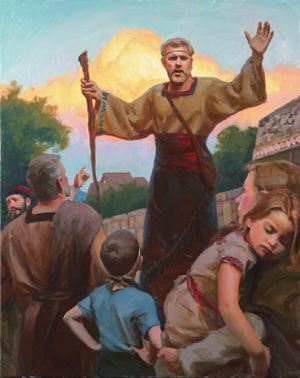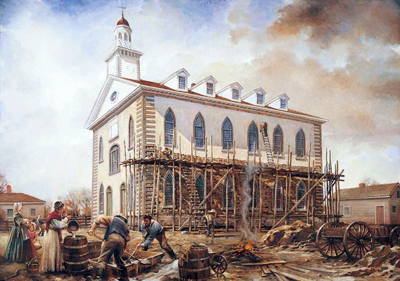
The Know
Throughout history, many civilizations and communities have sought to establish a perfect society, one which could provide prosperity and well-being for all of its citizens.1 This was especially true during the early period of the Restoration. American historian, Richard Bushman, noted, “Between 1787 and 1860, 137 communitarian experiments were undertaken in the United States. All sought to improve the world by forming miniature societies on ideal principles.”2
Many church converts in Ohio had been a part of one of these groups, known as “the Family.”3 They sincerely tried to live as an ideal community on Isaac Morley’s farm, but without divine revelation they misunderstood the principle of stewardship.4 In February of 1831, the Lord revealed the proper principles of consecration and stewardship (Doctrine and Covenants 42:32) and called Edward Partridge as the first bishop of the church to oversee the consecrated properties and administer stewardships to those who entered the covenant.5 In light of this revelation, the communal efforts at Morley’s farm were “readily abandoned for the more perfect law of the Lord.”6
Although subsequent revelations would expand on the Law of Consecration and adapt it to the needs of the Saints,7 many of its fundamental principles had already been taught in the Book of Mormon. For instance, Jacob taught his people that they should first seek “for the kingdom of God,” and then afterward it was appropriate to seek and obtain riches “for the intent to do good—to clothe the naked, and to feed the hungry, and to liberate the captive, and administer relief to the sick and the afflicted” (Jacob 2:18–19).
To help his people understand why this law was given, King Benjamin asked, “For behold, are we not all beggars? Do we not all depend upon the same Being, even God, for all the substance which we have, for both food and raiment, and for gold, and for silver, and for all the riches which we have of every kind?” (Mosiah 4:19).
“Alma commanded that the people of the church should impart of their substance, every one according to that which he had; if he have more abundantly he should impart more abundantly; and of him that had but little, but little should be required; and to him that had not should be given” (Mosiah 18:27).
Amulek warned that “if ye do not remember to be charitable, ye are as dross, which the refiners do cast out, (it being of no worth) and is trodden under foot of men” (Alma 34:29).
The Book of Mormon even demonstrates what can be achieved when a people collectively live this law. After the Savior’s ministry in 3 Nephi, they “had all things common among them; therefore there were not rich and poor, bond and free, but they were all made free, and partakers of the heavenly gift” (4 Nephi 1:3).8 In these and many other ways, the Book of Mormon can help readers understand the Law of Consecration and develop the faith to live it.
The Why
Unfortunately, during the early years of the Restoration, not all the Saints were enthusiastic about living the Lord’s law. One Church historian, Steven Harper, noted that “some saints [simply] refused. Others were untaught, and many were scattered. Some rebellious Saints even challenged the law in court.”9 For these reasons, the early implementation of this law was “temporarily suspended,” as described by Frank Hirschi.10 Yet the fundamental doctrines and principles of the law have continued on. President Gordon B. Hinckley affirmed that “the law of sacrifice and the law of consecration were not done away with and are still in effect.”11
President Henry B. Eyring explained that the Lord’s way of helping His children meet their temporal needs has “at times been called living the law of consecration. In another period His way was called the united order. In our time it is called the Church welfare program.” And while the “names and the details of operation are changed to fit the needs and conditions of people,” the Lord always “requires people who out of love have consecrated themselves and what they have to God and to His work.”12
The Book of Mormon provides powerful doctrines and moving examples of those who exemplified such love and consecration. LeGrand Baker found that the book “leads its readers to charity and thus to the personal fulfillment of the law of consecration.”13 On the other hand, the Book of Mormon shows how “a love of things [rather than a love of God or of fellow men] produces social separation and economic inequality.”14 It demonstrates how, like Zeezrom, one can overcome a lust for wealth and prestige.15 And it depicts how a willingness to give up every worldly possession, as in the case of King Lamoni’s father, can lead to repentance and conversion (see Alma 22:15).16
Elder Neal A. Maxwell recognized that ultimately, the “submission of one’s will is really the only uniquely personal thing we have to place on God’s altar.”17 Thus consecration is about much more than merely giving up surplus property to the poor, or receiving such properties if in need. It is about each individual giving himself or herself to the Lord, “with all your might, mind, and strength, and your whole soul” (2 Nephi 25:29). It entails a willingness to “give all of our time, talents, and means to the building up of the Lord’s earthly kingdom.”18
After the members of “the Family” who sought Zion at Isaac Morley’s farm willingly submitted to the Lord’s revelations, it was recorded that “unity and harmony prevailed throughout the church.”19 Communities that likewise live the Law of Consecration, as properly understood and taught by the Lord’s servants and beautifully portrayed in the Book of Mormon, will surely find their own abodes of peace and prosperity. As President Marion G. Romney taught, this law “exalts the poor and humbles the rich. In the process, both are sanctified.”20
Further Reading
Steven C. Harper, “All Things Are the Lord’s: The Law of Consecration in the Doctrine and Covenants,” in The Doctrine and Covenants: Revelations in Context, ed. Andrew H. Hedges, J. Spencer Fluhman, and Alonzo L. Gaskill (Salt Lake City and Provo, UT: Deseret Book and Religious Studies Center, Brigham Young University, 2008), 212–228.
Lindon J. Robison, “‘No Poor Among Them,’” Journal of Book of Mormon Studies 14, no. 1 (2005): 86–97, 130.
Neal A. Maxwell, “‘Swallowed Up in the Will of the Father,’” Ensign, November 1995, online at lds.org.
Frank W. Hirschi, “Law of Consecration” in Encyclopedia of Mormonism, 4 vols., ed. Daniel H. Ludlow (New York, NY: Macmillan, 1992), 1:312–314.
Marion G. Romney, “Living Welfare Principles,” Ensign, November 1981, online at lds.org.
- 1. See Hugh Nibley, Approaching Zion, The Collected Works of Hugh Nibley, Volume 9 (Salt Lake City and Provo, UT: Deseret Book and FARMS, 1989), 487–523.
- 2. Richard Lyman Bushman, Joseph Smith: Rough Stone Rolling (New York, NY: Vintage Books, 2005), 165.
- 3. See Steven C. Harper, “The Law,” in Revelations in Context: The Stories behind the Sections of the Doctrine and Covenants (Salt Lake City, UT: The Church of Jesus Christ of Latter-day Saints, 2016), online at lds.org.
- 4. For example, they believed that “what belonged to a brother belonged to any of the brethren,” leading them to “take each other’s clothes and other property and use it without leave: which brought on confusion and disappointments.” John Whitmer, History, 1831–circa 1847, p. 11, online at josephsmithpapers.org.
- 5. See Sherilyn Farnes, “‘A Bishop unto the Church,’” in Revelations in Context, online at lds.org.
- 6. History, 1838–1856, volume A-1, p. 93, online at josephsmithpapers.org.
- 7. See Doctrine and Covenants 51; 78; 82:17–21; 83; 85; 104.
- 8. See Lindon J. Robison, “‘No Poor Among Them,’” Journal of Book of Mormon Studies 14, no. 1 (2005): 86–97, 130. See also, Andrew C. Skinner, “Zion Gained and Lost: Fourth Nephi as the Quintessential Model,” in Fourth Nephi through Moroni, From Zion to Destruction, ed. Monte S. Nyman and Charles D. Tate Jr., The Book of Mormon Symposium Series, Volume 9 (Provo, UT: Religious Studies Center, Brigham Young University, 1995), 295: “The scriptural phrase ‘had all things in common’ is undoubtedly used to characterize those who lived the law of consecration.”
- 9. Harper, “The Law,” online at lds.org.
- 10. Frank W. Hirschi, “Law of Consecration” in Encyclopedia of Mormonism, 4 vols., ed. Daniel H. Ludlow (New York, NY: Macmillan, 1992), 1:312. See also, Karl Ricks Anderson, “Consecration in Ohio and Missouri,” in Encyclopedia of Mormonism, 1:314–315.
- 11. Gordon B. Hinckley, Teachings of Gordon B. Hinckley (Salt Lake City, UT: Deseret Book, 1997), 639.
- 12. Henry B. Eyring, “Opportunities to Do Good,” Ensign, May 2011, 22, online at lds.org.
- 13. LeGrand L. Baker, The Book of Mormon as an Ancient Israelite Temple: Nineteen Classic Temple Characteristics of the Book of Mormon (Salt Lake City, UT: Eborn Books, 2012), 132.
- 14. Robison, “‘No Poor Among Them,’” 93. See also, Book of Mormon Central, “Why Did Mormon Emphasize the Zoramites' Costly Apparel? (Alma 31:28),” KnoWhy 283 (March 6, 2017).
- 15. See Book of Mormon Central, “Why Would Zeezrom Attempt to Bribe Amulek? (Alma 11:22),” KnoWhy 118 (June 9, 2016). For Zeezrom’s repentance and transformation see, Alma 15:2–12.
- 16. The fact that Lamoni’s father was a powerful Lamanite king makes the story of his conversion, and his willingness to forsake his worldly possessions and status, even more meaningful. See Book of Mormon Central, “What Did It Mean to be King over All the Land? (Alma 20:8),” KnoWhy 128 (June 23, 2016).
- 17. Neal A. Maxwell, “‘Swallowed Up in the Will of the Father,’” Ensign, November 1995, online at lds.org.
- 18. Bruce R. McConkie, “Obedience, Consecration, and Sacrifice,” Ensign, May 1975, online at lds.org.
- 19. John Whitmer, History, 1831–circa 1847, p. 21, online at josephsmithpapers.org.
- 20. Marion G. Romney, “Living Welfare Principles,” Ensign, November 1981, online at lds.org.
Continue reading at the original source →





